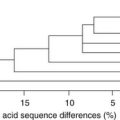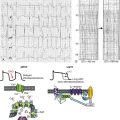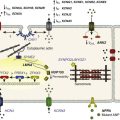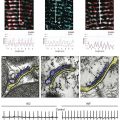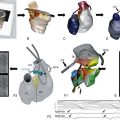Arrhythmias in Patients With Neurologic Disorders
Muscular Dystrophies
1. Duchenne and Becker muscular dystrophies
2. Type 1 and type 2 myotonic dystrophies
3. Emery-Dreifuss muscular dystrophies and associated disorders
Duchenne and Becker Muscular Dystrophies
Clinical Presentation
The majority of patients with Duchenne muscular dystrophy develop a cardiomyopathy, but clinical recognition can be masked by severe skeletal muscle weakness.1 Cardiac magnetic resonance (CMR) imaging detects early myocardial fibrosis. Predilection for involvement in the posterobasal and posterolateral left ventricle has been observed. Electrocardiograms are abnormal in 90% of patients with Duchenne muscular dystrophy, demonstrating a distinctive pattern of tall R waves and increased R/S amplitude in V1 and deep narrow Q waves in the left precordial leads related to the regional ventricular involvement. Up to 40% of individuals have PR intervals less than 120 ms. Cardiac involvement in Becker muscular dystrophy is more variable, ranging from none or subclinical to severe cardiomyopathy requiring transplant. Electrocardiographic abnormalities similar to that in Duchenne muscular dystrophy are present in up to 75% with echocardiographic abnormalities in 50%. The severity of cardiac involvement does not correlate with the degree of skeletal muscle weakness.
Type 1 and Type 2 Myotonic Dystrophies
Genetics and Cardiac Pathophysiology
The myotonic dystrophies are autosomal dominant disorders characterized by myotonia, which is a delayed muscle relaxation after contraction, weakness, and atrophy of skeletal muscles, and systemic manifestations that include cardiac involvement. Two distinct mutations are responsible for the myotonic dystrophies. In myotonic dystrophy type 1, a trinucleotide, cytosine-thymine-guanine (CTG) repeat expansion occurs in an untranslated region of chromosome 19. In myotonic dystrophy type 2, also called proximal myotonic myopathy, a tetranucleotide, CCTG repeat expansion occurs on chromosome 3. The mechanism responsible for the similar phenotype despite two different mutations is that the amplified DNA repeat sequence is transcribed into an amplified RNA that affects nuclear RNA binding proteins (RNA toxic gain-of-function) and subsequent downstream protein synthesis. A recent study suggests that cardiac pathology in both myotonic dystrophies is related to gap junction and calcium channel protein overexpression.2 The cardiac pathology observed includes preferential degeneration of the conduction system from the sinus node to the His-Purkinje fibers. Degenerative changes are observed in other atrial and ventricular tissue, but progression to a symptomatic structural cardiomyopathy is less common. Myocardial fibrosis and conduction system degeneration is progressive, leading to an age-dependent risk of arrhythmias. Although the pathology appears similar in types 1 and 2, type 1 typically has earlier and more severe cardiac involvement.
Clinical Presentation
Myotonic dystrophy is the most common inherited muscular dystrophy in adults with type 1, significantly more prevalent than type 2. In type 1, the age at onset of symptoms and diagnosis averages 20 to 25 years, and patients often die prematurely in the fifth or sixth decade.3 In type 1, a congenital presentation marked by severe involvement including neurocognitive abnormalities can occur. Patients with type 2 and less affected patients with type 1 live longer.
Arrhythmia Manifestations
Patients with myotonic dystrophy type 1 demonstrate a wide range of arrhythmias. Electrocardiograms are abnormal in 60% of middle-aged adults primarily showing abnormalities in conduction with prolonged PR interval and QRS duration. On an electrophysiological study, a prolonged His-ventricular interval is often present.4
Conduction system disease can progress to symptomatic heart block and necessitate pacing. The prevalence of pacemakers varies widely between studies based on referral patterns and indications.3,4 Atrial arrhythmias, primarily fibrillation and flutter, are common. Patients with atrial arrhythmias are often asymptomatic possibly because of a controlled ventricular response from concomitant conduction disease. Up to one third of individuals with myotonic dystrophy type 1 die suddenly. The mechanisms leading to sudden death are not clear, but are believed to be related primarily to arrhythmia. Asystole, owing to complete heart block without an appropriate escape rhythm, has been considered a probable cause. Sudden death can occur despite pacemakers implicating ventricular arrhythmias. Patients with myotonic dystrophy type 1 are at risk for bundle branch reentry tachycardia because of associated conduction disease. Arrhythmias are observed in patients with myotonic dystrophy type 2, but are less frequent and occur later in life. Unexplained sudden death has been reported.5
Treatment and Prognosis
Neurologists and neuromuscular specialists appropriately refer myotonic patients to cardiology or electrophysiology for assessment and treatment. In patients with symptoms consistent with arrhythmias, electrophysiological evaluation to determine an etiology is mandatory. Annual electrocardiograms and consideration for 24-hour ambulatory monitoring have been recommended as screening evaluations in asymptomatic patients. In a large, myotonic dystrophy type 1 cohort, the presence of severe electrocardiographic conduction abnormalities (non–sinus rhythm, PR interval ≥ 240 ms, QRS duration ≥ 120 ms, or second- or third-degree atrioventricular block) and a clinical diagnosis of atrial arrhythmias were independent factors predicting sudden death.3 The 2008 guideline update for device-based therapy of cardiac rhythm abnormalities has recognized that asymptomatic electrocardiographic conduction abnormalities, including first degree atrioventricular or fascicular block in neuromuscular diseases such as myotonic dystrophy, warrant special consideration for prophylactic pacing.6 Electrophysiological study for determination of the severity of His-Purkinje disease has been recommended. In a retrospective observational evaluation performed in a referred myotonic dystrophy type 1 cohort, an invasive strategy using electrophysiologic study to guide pacing if the H-V interval is 70 ms or greater decreased the frequency of sudden death compared with a noninvasive strategy observational group.4 Sudden death occurs despite pacemakers, and the ICD may be the preferential therapy in patients being considered for a prophylactic device.7 In patients with wide complex tachycardia, an electrophysiologic study with particular evaluation for bundle branch reentry tachycardia should be done.
Emery-Dreifuss Muscular Dystrophies and Associated Disorders
Genetics and Cardiac Pathophysiology
Emery-Dreifuss muscular dystrophy is an inherited disorder in which skeletal muscle involvement is often mild, but with cardiac and arrhythmia involvement that is common and life threatening. The disease is classically inherited in an X-linked recessive fashion, but heterogeneity is observed with an autosomal dominant inheritance that is, in fact, more common. The gene abnormality responsible for the X-linked recessive Emery-Dreifuss muscular dystrophy is a deficiency in a nuclear membrane protein termed emerin. Mutations in the LMNA gene found on chromosome 1 encoding two other nuclear membrane proteins, lamin A and C, have been identified as responsible for a multitude of degenerative disorders collectively termed laminopathies with a cardiac phenotype similar to that of the X-linked Emery-Dreifuss muscular dystrophy.8 Less than half of patients with Emery-Dreifuss muscular dystrophy have mutations in emerin or lamin A/C, and mutations affecting other nuclear membrane proteins have been identified. The nuclear membrane proteins provide structural support for the nucleus and interact with the cell’s cytoskeleton. Abnormalities in the nuclear proteins might not allow the nucleus and cell to tolerate mechanical stress (the nuclear fragility mechanism), and chromatin structure and subsequent downstream proteins can be adversely affected (the gene expression mechanism).9 Pathologic studies have shown fibrotic replacement of cardiac muscle and conduction tissue.
Clinical Presentation
A triad of early contractures of the elbow, Achilles tendon, and posterior cervical muscles, slowly progressing muscle weakness and atrophy, and cardiac involvement characterizes Emery-Dreifuss muscular dystrophy. There is a significant variation in the phenotypic expression of the various other subtypes of laminopathies.8 Both arrhythmias and a dilated cardiomyopathy occur in Emery-Dreifuss muscular dystrophy and the associated disorders. Often the first manifestation is conduction disease and heart block requiring pacing. The dilated cardiomyopathy tends to be observed later.
Arrhythmia Manifestations
Abnormalities in impulse generation and conduction are common in Emery-Dreifuss muscular dystrophy and associated disorders. Electrocardiograms are typically abnormal by 20 to 30 years of age, with an early manifestation of first-degree atrioventricular block. The atria are involved before the ventricles, with atrial fibrillation or flutter or classically, with permanent atrial standstill and a junctional bradycardia. A need for pacing support is typical by 35 to 40 years of age. Sudden death is common in Emery-Dreifuss muscular dystrophy and associated disorders, including in those who have received pacemakers. Ventricular tachycardia and fibrillation occur. Risk factors for sudden death and appropriate ICD therapy include nonsustained ventricular tachycardia, left ventricular ejection fraction less than 45%, male sex, and lamin A or C non-missense mutations.10 Female carriers of X-linked Emery-Dreifuss muscular dystrophy are at risk of cardiac conduction disease and sudden death, typically occurring late in life.
Treatment and Prognosis
Affected patients should be monitored carefully for electrocardiographic conduction abnormalities and left ventricular dysfunction. Ambulatory monitoring can reveal asymptomatic ventricular arrhythmias that have prognostic significance. Pacing support is recommended once conduction disease is evident, although the severity at which pacing should be instituted is not clear. Dual-chamber pacing might not be possible if atrial standstill is present. An ICD rather than bradycardia protection alone is the preferred prophylactic therapy.10,11 Pharmacotherapy for dilated cardiomyopathy and heart failure in these diseases has not been studied, but it would be appropriate given the known progression.
Limb-Girdle Muscular Dystrophies
Genetics and Cardiac Pathophysiology
Limb-girdle muscular dystrophies are a group of disorders with a limb–shoulder and pelvic girdle distribution of weakness, but otherwise with heterogeneous inheritance and clinical features. Autosomal recessive (subtypes 2A to 2P), dominant (subtypes 1A to 1H), and sporadic inheritance has been observed.12 Genes involved include those encoding dystrophin-associated glycoproteins, sarcomeric proteins, sarcolemma proteins, nuclear membrane proteins, and cellular enzymes. An autosomal dominant limb-girdle muscular dystrophy (subtype 1B) with a high prevalence of arrhythmias and a late dilated cardiomyopathy is caused by mutations encoding lamin A/C, similar to in Emery-Dreifuss muscular dystrophy. An autosomal recessive or sporadic limb-girdle muscular dystrophy associated with a progressive dilated cardiomyopathy is caused by mutations affecting the function of the dystrophin-glycoprotein complex, including sarcoglycan and fukutin-related proteins (subtypes 2C-F, 2I). An autosomal recessive limb-girdle muscular dystrophy associated with a variable onset of a dilated cardiomyopathy is caused by a mutation in a sarcolemmal repair protein termed dysferlin (subtype 2B). Other subtypes of limb-girdle muscular dystrophy are not commonly associated with cardiac or arrhythmia abnormalities.
Arrhythmia Manifestations
Arrhythmias occur in limb-girdle muscular dystrophy limited to specific genetic subtypes. In subtype 1B, the cardiac phenotype is similar to Emery-Dreifuss muscular dystrophy. Progressive conduction disease occurs commonly requiring pacing.11 Sudden death occurs, including in those with a pacemaker. Risk factors for sudden death and appropriate ICD therapy include nonsustained ventricular tachycardia, left ventricular ejection fraction less than 45%, male sex, and lamin A or C non-missense mutations.10 A late dilated cardiomyopathy can be seen. The primary clinical manifestation of the subtypes of limb-girdle muscular dystrophy affecting the dystrophin-glycoprotein complex (subtypes 2C to 2F, 2I) is a dilated cardiomyopathy. Specific arrhythmias have not been reported, but it is anticipated that there is risk associated with the cardiomyopathy. A dilated cardiomyopathy can occur in subtype 2B (dysferlinopathy).
Treatment and Prognosis
Routine screening of the electrocardiogram and echocardiogram in the subtypes of limb-girdle muscular dystrophy associated with cardiac disease is indicated. Patients with a dilated cardiomyopathy should be treated with standard heart failure therapy. Prophylactic implantation of a cardioverter-defibrillator rather than pacemaker is recommended in patients with limb-girdle muscular dystrophy subtype 1B when cardiac conduction disease is present.10,11
Facioscapulohumeral Muscular Dystrophy
Arrhythmia Manifestations
Arrhythmia involvement in facioscapulohumeral muscular dystrophy is reported, but it does not constitute as significant a problem in prevalence or severity as in other muscular dystrophies. In a patient series evaluating cardiac abnormalities, 5% to 12% of patients were noted to have arrhythmias in the absence of cardiovascular risk factors.13 Arrhythmias reported included supraventricular, atrioventricular block, and ventricular tachycardia. Many of the patients were asymptomatic or had mild palpitations.
Friedreich’s Ataxia
Genetics and Cardiac Pathophysiology
Friedreich’s ataxia is an autosomal recessive spinocerebellar degenerative disease characterized by ataxia of the limbs and trunk, dysarthria, loss of deep tendon reflexes, sensory abnormalities, skeletal deformities, and cardiac involvement.14 The primary genetic abnormality is an expansion of a trinucleotide repeat, guanine-adenine-adenine in an intron of a gene that encodes a 210-amino acid mitochondrial protein called frataxin. Loss of frataxin effects mitochondrial iron homeostasis making the cell susceptible to oxidative stress. Friedreich’s ataxia is associated with a concentric hypertrophic cardiomyopathy. More rarely, asymmetric septal hypertrophy or a late dilated cardiomyopathy occurs.
Clinical Presentation
Neurologic symptoms typically manifest at puberty and almost always before 25 years of age. Most neurologically symptomatic patients have cardiac abnormalities, primarily findings of ventricular hypertrophy. Approximately 70% of patients will have an abnormal echocardiogram, with the majority showing increased wall thickness and, more rarely, systolic dysfunction.15
Treatment and Prognosis
Idebenone, a free radical scavenger related to coenzyme Q10, has shown variable efficacy in decreasing cardiac hypertrophy.16 Individuals progressing to a dilated cardiomyopathy should be treated with standard heart failure pharmacotherapy, but they tend to do poorly. Heart failure is the most common cause of death.17 Arrhythmias can complicate heart failure. The role of ICDs in Friedreich’s ataxia is unclear.
Periodic Paralyses
Genetics, Cardiac Pathophysiology, and Clinical Presentation
The primary periodic paralyses are rare, nondystrophic, autosomal dominant disorders that result from abnormalities in ion channel genes.18 They can be classified into hypokalemic and hyperkalemic periodic paralyses and Andersen-Tawil (long QT 7) syndrome. In addition, acquired hypokalemic periodic paralysis can complicate thyrotoxicosis, especially in men of Asian descent. All these paralyses can manifest with episodic attacks of flaccid paralysis precipitated by variable environmental stimuli. A late-onset fixed myopathy can occur in hypokalemic and hyperkalemic periodic paralyses.
In hypokalemic periodic paralysis, attacks are precipitated by carbohydrate load or rest after exercise and are associated with decreased serum potassium levels at onset. Penetrance is incomplete, especially in women. Hypokalemic periodic paralyses is caused by point mutations in the α1-subunit of the dihydropyridine-sensitive calcium channel (CACNA1S) or in the α-subunit of the skeletal muscle sodium channel (SCN4A). Approximately 20% of cases are of uncertain genetic cause. One third of thyrotoxic hypokalemic periodic paralysis is associated with mutations in an inward rectifier potassium channel, Kir2.6, which is regulated by thyroid hormone. In hyperkalemic periodic paralysis, episodic weakness is precipitated by exercise and fasting, with symptoms worsening with potassium supplementation. Myotonia can also be seen. Complete penetrance is observed. Potassium levels are usually high, but can be normal during an attack. Hyperkalemic periodic paralysis is caused primarily by point mutations in the α-subunit of SCN4A. Genetic heterogeneity is observed. Andersen-Tawil syndrome is a distinct periodic paralysis characterized by dysmorphic features of low-set ears, micrognathia, hypertelorism, clinodactyly, long QT interval, and ventricular arrhythmias.19 Episodic weakness can be triggered by hyperkalemia, hypokalemia, or normokalemia. Response to potassium supplementation is inconsistent. Mutations in the KCNJ2 gene encoding an inward rectifier K+ channel (Kir2.1) that is expressed in skeletal and cardiac muscle is the cause in approximately 60% of cases. What genes are involved in KCNJ2-negative families is uncertain. Andersen-Tawil syndrome has been given an alternative nomenclature of long QT 7.
Arrhythmia Manifestations
The periodic paralyses are associated with ventricular arrhythmias. Most arrhythmias occur with hyperkalemic periodic paralysis and Andersen-Tawil syndrome. Bidirectional ventricular tachycardia has been observed independent of digitalis toxicity. The bidirectional ventricular tachycardia occurs without relation to attacks of muscle weakness, generally does not correlate with serum potassium levels, and can convert to sinus rhythm with exercise. Ventricular ectopy is often seen interspersed with bidirectional tachycardia. The tachycardia tends to be slow (less than 150 beats/min) and tolerated. It can be frequent enough to be the cause of a tachycardia-mediated cardiomyopathy. A prolonged QT interval may be observed. In some reports, it is episodic and associated with weakness, hypokalemia, or antiarrhythmic therapy. In other cases, prolonged QT interval is constant. Thyrotoxic hypokalemic periodic paralysis often demonstrates the electrocardiographic findings of sinus tachycardia, prolonged QT-U intervals, and first-degree atrioventricular block.20 In Andersen-Tawil syndrome, a prolonged QT interval can be observed, although a prolonged QU interval with prominent and wide U wave is more frequent. Serious ventricular arrhythmias including torsades de pointes leading to syncope, cardiac arrest, and sudden death have been reported in the periodic paralyses. The characteristics that predict an increased risk of life-threatening arrhythmias are not clear. In Andersen-Tawil syndrome, the likelihood of malignant ventricular arrhythmias appears to be less than in the other long QT syndromes.
Treatment and Prognosis
The episodes of weakness commonly respond to measures that normalize potassium levels. Weakness in hyperkalemic periodic paralysis can respond to mexiletine. Weakness in hypokalemic periodic paralysis can respond to acetazolamide. Treatment of electrolytes usually does not improve arrhythmias; if it does, the effect is transient. Improvement in symptomatic nonsustained ventricular tachycardia associated with a prolonged QT interval has been reported with β-blocker therapy. Amiodarone has been observed to decrease episodes of sustained polymorphic ventricular tachycardia in Andersen-Tawil syndrome. Flecainide has been observed to decrease episodes of bidirectional ventricular tachycardia in Andersen-Tawil syndrome.21 The use of ICDs has been reported. Normalization of thyroid indices corrects both the episodic weakness and electrocardiographic abnormalities in thyrotoxic hypokalemic periodic paralysis.
Mitochondrial Disorders
Clinical Presentation
Cardiac involvement in mitochondrial disorders is common. In Kearns-Sayre syndrome, conduction abnormalities are typical, with a dilated cardiomyopathy reported, but less common. In MERRF and MELAS, left ventricular hypertrophy, systolic dysfunction, or diastolic dysfunction can be observed.22 LHON is characterized by painless, subacute bilateral visual loss, more commonly occurring in males than females. A hypertrophic cardiomyopathy has been observed.
Arrhythmia Manifestations
The clinical triad of progressive external ophthalmoplegia, pigmentary retinopathy, and onset before 20 years of age characterizes Kearns-Sayre syndrome. Cardiac involvement primarily manifests as progressive conduction disease resulting in heart block.23 Heart block typically appears after eye involvement. The His-ventricular interval is prolonged. Pacing can be required before 20 years of age. A short PR interval and pre-excitation syndromes have been observed by some but not all investigators evaluating patients with LHON. Despite the presence of left ventricular hypertrophy or dilatation and heart failure, arrhythmias are uncommon in MERRF and MELAS. Preexcitation has been described with both diseases.
Guillain-Barré Syndrome
Clinical Presentation
Guillain-Barré syndrome is an acute inflammatory demyelinating neuropathy characterized by peripheral, cranial, and autonomic nerve dysfunction.24 In two thirds of affected patients, a viral or bacterial illness, typically respiratory or gastrointestinal, precedes the onset of symptoms by up to 6 weeks. Patients have pain, paresthesias, and progressive weakness. One fourth of patients require assisted ventilation. Up to 15% of hospitalized patients die.
Arrhythmia Manifestations
Arrhythmias occur in Guillain-Barré syndrome related to involvement of the autonomic nervous system.25 Life-threatening arrhythmias occur almost exclusively in severe cases requiring assisted ventilation. In a prospective study of 100 patients, serious arrhythmias occurred in 11 of 33 patients requiring ventilation.26 This study included asystole in six, bradycardia of less than 30 beats per minute in one, rapid atrial fibrillation in two, and ventricular tachycardia or fibrillation in two. Thirteen deaths occurred with four were arrhythmia related. Asystole was often triggered with tracheal suctioning.
Myasthenia Gravis
Epilepsy
Clinical Presentation and Cardiac Pathophysiology
Epilepsy is a complex brain disorder characterized by recurrent seizures. Patients with epilepsy are at an increased risk of sudden death of unknown cause that has been termed sudden unexpected death in epilepsy.27,28 A recommendation for labeling the death as sudden, unexpected, seizure-induced death reflects that most events occur during or in proximity to a seizure. Sudden unexpected death is a frequent cause of premature mortality in epilepsy with, an incidence varying from 0.09 to 9.3 per 1000 patient-years, depending on the population studied.27 Adults with longstanding epilepsy are at the highest risk. The mechanisms leading to sudden death in epilepsy are not clear and likely vary. Central or obstructive apnea, excessive respiratory secretions, acute pulmonary edema, and arrhythmias could all be involved.
Arrhythmia Manifestations
Sinus arrest and asystole during the periictal period was observed in 21% of patients with poorly controlled epilepsy who were undergoing long-term rhythm monitoring with an insertable loop recorder.28 The findings are not consistent with other studies because severe bradycardia was observed in less than 0.5% of patients undergoing video electroencephalographic monitoring at referral epilepsy centers. Peri-ictal bradycardia is more common in patients with temporal lobe seizures. Primary ventricular arrhythmia disorders such as long QT syndrome or right ventricular dysplasia can appear with symptoms suggestive of epilepsy and could be responsible for a small proportion of sudden deaths. Risk factors for sudden unexpected death in epilepsy include a higher seizure frequency, earlier onset, and longer duration of epilepsy, and the need for three or more antiepileptic drugs.
Acute Cerebrovascular Disease
Cardiac Pathophysiology
Cardiac abnormalities including life-threatening arrhythmias occur in acute cerebrovascular disease including subarachnoid hemorrhage, other stroke syndromes, and head injury.29 The mechanism responsible for cardiac involvement is related to autonomic nervous system dysfunction with both increased sympathetic and parasympathetic output accompanying intracranial pathology. Hypothalamic stimulation reproduces the electrocardiographic changes observed in acute cerebrovascular disease. Electrocardiographic changes associated with hypothalamic stimulation or blood in the subarachnoid space can be prevented with spinal cord transection, stellate ganglion blockade, vagolytics, and adrenergic blockers. In some cases, acute cerebrovascular disease can be associated with the clinical picture of takotsubo cardiomyopathy.30
Arrhythmia Manifestations
Cardiac and arrhythmia involvement is most common in patients with subarachnoid hemorrhage. Electrocardiographic abnormalities are observed in up to 80% of patients with a higher risk in those with more severe neurologic injury.31 Peaked and inverted T waves and a prolonged QT interval are seen. Hypokalemia is observed in up to half of patients increasing the likelihood of QT interval prolongation. Bradycardia with sinoatrial block, sinus arrest, and atrioventricular block can occur. Ventricular tachycardia including torsades de pointes and ventricular fibrillation have been reported. Prolongation of the QT interval and hypokalemia are risk factors for ventricular arrhythmias.
References
1. Romfh, A, McNally, EM. Cardiac assessment in duchenne and becker muscular dystrophies. Curr Heart Fail Rep. 2010; 7:212–218.
2. Rau, F, Freyermuth, F, Fugier, C, et al. Misregulation of miR-1 processing is associated with heart defects in myotonic dystrophy. Nature Struct Mol Biol. 2011; 18:840–845.
3. Groh, WJ, Groh, MR, Chandan, S, et al. Electrocardiographic abnormalities and risk of sudden death in myotonic dystrophy type 1. N Engl J Med. 2008; 358:2688–2697.
4. Wahbi, K, Meune, C, Porcher, R, et al. Electrophysiological study with prophylactic pacing and survival in adults with myotonic dystrophy and conduction system disease. J Am Med Assoc. 2012; 307:1292–1301.
5. Schoser, BG, Ricker, K, Schneider-Gold, C, et al. Sudden cardiac death in myotonic dystrophy type 2. Neurology. 2004; 63:2402–2404.
6. Epstein, AE, DiMarco, JP, Ellenbogen, KA, et al. ACC/AHA/HRS 2008 guidelines for device-based therapy of cardiac rhythm abnormalities. Circulation. 2008; 117:e350–e408.
7. Bhakta, D, Shen, C, Kron, J, et al. Pacemaker and implantable cardioverter-defibrillator use in a US myotonic dystrophy type 1 population. J Cardiovasc Electrophysiol. 2011; 22:1369–1375.
8. Puckelwartz, M, McNally, EM. Emery-Dreifuss muscular dystrophy. Handbook Clin Neurol. 2011; 101:155–166.
9. Ellis, JA. Emery-Dreifuss muscular dystrophy at the nuclear envelope: 10 years on. Cell Mol Life Sci. 2006; 63:2702–2709.
10. van Rijsingen, IW, Arbustini, E, Elliott, PM, et al. Risk factors for malignant ventricular arrhythmias in lamin A/C mutation carriers: A European Cohort Study. J Am Coll Cardiol. 2012; 59:493–500.
11. Meune, C, Van Berlo, JH, Anselme, F, et al. Primary prevention of sudden death in patients with lamin A/C gene mutations. N Engl J Med. 2006; 354:209–210.
12. Nigro, V, Aurino, S, Piluso, G. Limb girdle muscular dystrophies: update on genetic diagnosis and therapeutic approaches. Curr Opin Neurol. 2011; 24:429–436.
13. Trevisan, CP, Pastorello, E, Armani, M, et al. Facioscapulohumeral muscular dystrophy and occurrence of heart arrhythmia. Eur Neurol. 2006; 56:1–5.
14. Pandolfo, M. Friedreich ataxia. Handbook Clin Neurol. 2012; 103:275–294.
15. Weidemann, F, Rummey, C, Bijnens, B, et al. The heart in Friedreich ataxia: definition of cardiomyopathy, disease severity, and correlation with neurologic symptoms. Circulation. 2012; 125:1626–1634.
16. Lagedrost, SJ, Sutton, MSJ, Cohen, MS, et al. Idebenone in Friedreich ataxia cardiomyopathy-results from a 6-month phase III study. Am Heart J. 2011; 161:639–645.
17. Tsou, AY, Paulsen, EK, Lagedrost, SJ, et al. Mortality in Friedreich ataxia. J Neurol Sci. 2011; 307:46–49.
18. Finsterer, J. Primary periodic paralyses. Acta Neurol Scan. 2008; 117:145–158.
19. Tristani-Firouzi, M, Etheridge, SP. Kir 2. 1 channelopathies: the Andersen-Tawil syndrome. Eur J Physiol. 2010; 460:289–294.
20. Goldberger, ZD. Images in cardiovascular medicine. An electrocardiogram triad in thyrotoxic hypokalemic periodic paralysis. Circulation. 2007; 115:e179–e180.
21. Bokenkamp, R, Wilde, AA, Schalij, MJ, Blom, NA. Flecainide for recurrent malignant ventricular arrhythmias in two siblings with Andersen-Tawil syndrome. Heart Rhythm. 2007; 4:508–511.
22. Wahbi, K, Larue, S, Jardel, C, et al. Cardiac involvement is frequent in patients with the m. 8344A>G mutation of mitochondrial DNA. Neurology. 2010; 74:674–677.
23. Welzing, L, von Kleist-Retzow, JC, Kribs, A, et al. Rapid development of life-threatening complete atrioventricular block in Kearns-Sayre syndrome. Eur J Ped. 2009; 168:757–759.
24. Pritchard, J. Guillain-Barre syndrome. Clin Med. 2010; 10:399–401.
25. Kordouni, M, Jibrini, M, Siddiqui, MA. Long-term transvenous temporary pacing with active fixation bipolar lead in the management of severe autonomic dysfunction in Miller-Fisher syndrome: a case report. Int J Cardiol. 2007; 117:e10–e12.
26. Winer, JB, Hughes, RA. Identification of patients at risk of arrhythmia in the Guillain-Barre syndrome. Quar J Med. 1988; 68:735–739.
27. Devinsky, O. Sudden, unexpected death in epilepsy. N Engl J Med. 2011; 365:1801–1811.
28. Shorvon, S, Tomson, T. Sudden unexpected death in epilepsy. Lancet. 2011; 378:2028–2038.
29. Naidech, AM, Kreiter, KT, Janjua, N, et al. Cardiac troponin elevation, cardiovascular morbidity, and outcome after subarachnoid hemorrhage. Circulation. 2005; 112:2851–2856.
30. Das, M, Gonsalves, S, Saha, A, et al. Acute subarachnoid haemorrhage as a precipitant for takotsubo cardiomyopathy: a case report and discussion. Int J Cardiol. 2009; 132:283–285.
31. Sakr, YL, Ghosn, I, Vincent, JL. Cardiac manifestations after subarachnoid hemorrhage: a systematic review of the literature. Prog Cardiovasc Dis. 2002; 45:67–80.

